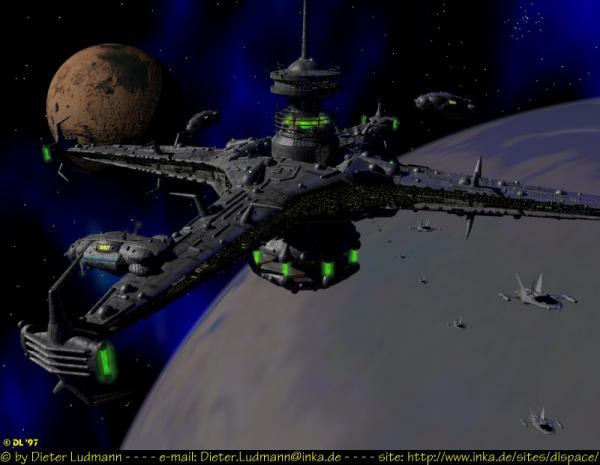BY LETTER
Hazard Rating
 Image from Dieter Ludmann (copyright; used with permission) |
It is common for short summaries of worlds and systems, habitats, or polities to include a Hazard Rating. The Hazard Rating system most widely used today is descended from one first compiled on Ken Ferjik in 8463 AT. This was a synthesis of some much older models, some of which themselves dated back to the early Interstellar Era. At various times since then the system has grown tremendously in size and complexity, only to be trimmed back and simplified in a later generation. The present fashion is to use a relatively simple set of calculations to produce a number between one and ten.
Like IQ, EQ, the various toposophic level classification systems, and other attempts to reify complex phenomena, the Hazard Rating is a useful summary but contains significant practical pitfalls and must be used with discretion.
The standard modern Hazard Rating assumes that the visitor to the region in question is a modosophont. Since modosophonts vary considerably in environmental requirements, the Hazard Rating uses an extremely complex system to "average" the mental and physical traits of typical travelers to the area and bases estimates on this model sophont being. The hazards themselves are selected from a large number of possible accidents or disasters that might take place, either during a visit or afterwards as a consequence of such a visit. These include such things as death, dismemberment, acquisition of hostile viruses, nano, or other hostile goo, loss of social status, imprisonment, impoverishment, involuntary uploading, downloading or conversion of substrate, involuntary suspension, torture, bodyjacking, subsumption, meme theft, rape (or equivalents), and involuntary personality alteration.
Where they are presented by interactive media, hazard ratings are tailored to the reader's clade, social group and status, education, associates, personality, and known history. Hyperlinks allow exploration of the weightings and implicit assumptions behind the number if the reader has the time and interest. Sensible travelers make these additional investigations before planning a trip.
The Basic Hazard Rating Scale
0: Cannot be physically or psychologically harmed, have one's memeset perverted, or have one's fundamental sentient rights (Sephirotic, Deeper Covenant, or other Civilized Galaxy equivalents) in any way attacked, while the system/situation is in operation. If said system were maintained indefinitely then no injury or interference would occur within the lifetime of the universe. This is the rating of a transapientech Sephirotic and equivalent angelnet system.
1: The equivalent of a very peaceful and safe non-angelnetted (or only partially angelnetted) environment. Serious violations of sentient rights are unknown and impossible while safeguards remain in force. Crime is almost completely unknown, but there may still be accidents, loss of status, and so on, although these are rare and minor thanks to extensive ai or companion advisory and precautionary systems. Partially angelnetted environments in the Civilized Galaxy, and non-angelnetted utopias or sanctuaries, fall into this category.
2: An average protected but non-angelnetted environment. Minor violation of sentient rights may occur, as may loss of wealth or social status. Crime, aggressive subversion, and other violations of sentient rights are rare and usually trivial but not unknown. Modosophont and transapient regimes that abuse sentient rights are unknown.
3: A mildly risky environment or industrial area, a populated region or society in which there is criminal activity; an area with occasional unpredictable transapients; many frontier polities.
4: A somewhat hazardous industrial environment; an unregulated wild frontier polity; a sapient or transapient regime that may choose to disregard sentient rights; a region which includes one or more unpredictable non-sephirotic transapients; an area characterized by microbial or bionano infection (due to poor hygiene or strong bionano ecologies); an area of wilderness inhabited by occasionally dangerous natural or artificial wildlife.
5: Dangerous or very risky extreme sports; an industrial environment containing hazardous nano or other materials; a high crime extreme tourism region; an unregulated and dangerous wild frontier polity; a polity characterized by a paranoid autocratic regime; a region under the control of unpredictable (ahuman, non-aligned, or other) non-sephirotic transapients; an area of wilderness inhabited by dangerous and numerous subsophonts; a region where microbial or bionano infection is chronic; a war zone with sporadic or occasional shooting.
6: A dangerous industrial environment with very hazardous materials or nano, a region of microbial or bionanonic plague; moderately offensive (but not extreme) nano goo; a war zone with frequent small arms fire; a region under the control of unpredictable and occasionally hostile ahuman non-sephirotic transapients; an ultratech or transapientech environment where involuntary conversion of substrate may occur; an environment with landmines, goo-capsules, or unexploded ordinance.
7: A bad war zone with heavy fighting, snipers, active nests of military synsects, etc.; the vicinity of a dangerous blight; an ultratech, transapientech environment where involuntary uploading, downloading or conversion of substrate may occur without any warning.
8: A region of offensive microbots or nanoswarms, a region of highly infectious bionano, or of offensive nano goo, an active blight.
9: Immediate fatality within a very short period (~10 seconds).
10: Instant fatality (within micro- or nanoseconds).
Appears in Topics
Development Notes
Text by Stephen Inniss and M. Alan Kazlev
Initially published on 25 July 2005.
Initially published on 25 July 2005.






